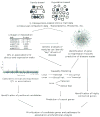Systems genetics: a novel approach to dissect the genetic basis of osteoporosis
- PMID: 22802146
- PMCID: PMC3422742
- DOI: 10.1007/s11914-012-0112-5
Systems genetics: a novel approach to dissect the genetic basis of osteoporosis
Abstract
From the early 1990s to the middle of the last decade, the search for genes influencing osteoporosis proved difficult with few successes. However, over the last 5 years this has begun to change with the introduction of genome-wide association (GWA) studies. In this short period of time, GWA studies have significantly accelerated the pace of gene discovery, leading to the identification of nearly 100 independent associations for osteoporosis-related traits. However, GWA does not specifically pinpoint causal genes or provide functional context for associations. Thus, there is a need for approaches that provide systems-level insight on how associated variants influence cellular function, downstream gene networks, and ultimately disease. In this review we discuss the emerging field of "systems genetics" and how it is being used in combination with and independent of GWA to improve our understanding of the molecular mechanisms involved in bone fragility.
Conflict of interest statement
Conflicts of interest: C.R. Farber: has received grant support from NIAMS/NIH (R01 grant support).
Figures

Similar articles
-
Using "-omics" Data to Inform Genome-wide Association Studies (GWASs) in the Osteoporosis Field.Curr Osteoporos Rep. 2021 Aug;19(4):369-380. doi: 10.1007/s11914-021-00684-w. Epub 2021 Jun 14. Curr Osteoporos Rep. 2021. PMID: 34125409 Free PMC article. Review.
-
Insights into the genetics of osteoporosis from recent genome-wide association studies.Expert Rev Mol Med. 2011 Aug 26;13:e28. doi: 10.1017/S1462399411001980. Expert Rev Mol Med. 2011. PMID: 21867596 Review.
-
The genetics of osteoporosis.Br Med Bull. 2015 Mar;113(1):73-81. doi: 10.1093/bmb/ldu042. Epub 2015 Jan 29. Br Med Bull. 2015. PMID: 25634850 Review.
-
Dissecting the Genetics of Osteoporosis using Systems Approaches.Trends Genet. 2019 Jan;35(1):55-67. doi: 10.1016/j.tig.2018.10.004. Epub 2018 Nov 20. Trends Genet. 2019. PMID: 30470485 Free PMC article. Review.
-
Using GWAS to identify novel therapeutic targets for osteoporosis.Transl Res. 2017 Mar;181:15-26. doi: 10.1016/j.trsl.2016.10.009. Epub 2016 Oct 27. Transl Res. 2017. PMID: 27837649 Free PMC article. Review.
Cited by
-
Integrative analysis of GWASs, human protein interaction, and gene expression identified gene modules associated with BMDs.J Clin Endocrinol Metab. 2014 Nov;99(11):E2392-9. doi: 10.1210/jc.2014-2563. Epub 2014 Aug 13. J Clin Endocrinol Metab. 2014. PMID: 25119315 Free PMC article.
-
Genome-wide approaches for identifying genetic risk factors for osteoporosis.Genome Med. 2013 May 29;5(5):44. doi: 10.1186/gm448. eCollection 2013. Genome Med. 2013. PMID: 23731620 Free PMC article. Review.
-
Socioeconomic status and bone mineral density in adults by race/ethnicity and gender: the Louisiana osteoporosis study.Osteoporos Int. 2017 May;28(5):1699-1709. doi: 10.1007/s00198-017-3951-1. Epub 2017 Feb 24. Osteoporos Int. 2017. PMID: 28236128
-
Integration of summary data from GWAS and eQTL studies identified novel causal BMD genes with functional predictions.Bone. 2018 Aug;113:41-48. doi: 10.1016/j.bone.2018.05.012. Epub 2018 May 12. Bone. 2018. PMID: 29763751 Free PMC article.
-
Osteoporosis GWAS-implicated DNM3 locus contextually regulates osteoblastic and chondrogenic fate of mesenchymal stem/progenitor cells through oscillating miR-199a-5p levels.JBMR Plus. 2024 Apr 10;8(5):ziae051. doi: 10.1093/jbmrpl/ziae051. eCollection 2024 May. JBMR Plus. 2024. PMID: 38686038 Free PMC article.
References
-
- Reginster J-Y, Burlet N. Osteoporosis: a still increasing prevalence. Bone. 2006;38:S4–9. - PubMed
-
- Anonymous: Consensus development conference: diagnosis, prophylaxis, and treatment of osteoporosis. The American Journal of Medicine. 1993;94:646–650. - PubMed
-
- Gass M, Dawson-Hughes B. Preventing osteoporosis-related fractures: an overview. Am J Med. 2006;119:S3–S11. - PubMed
-
- Seeman E, Delmas PD. Bone quality--the material and structural basis of bone strength and fragility. N Engl J Med. 2006;354:2250–2261. - PubMed
-
- Peacock M, Turner CH, Econs MJ, et al. Genetics of osteoporosis. Endocrine Reviews. 2002;23:303–326. - PubMed
Publication types
MeSH terms
Grants and funding
LinkOut - more resources
Full Text Sources
Medical

